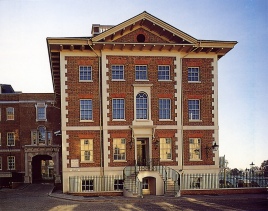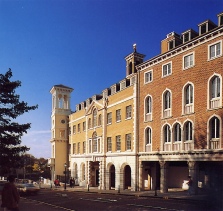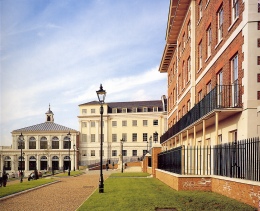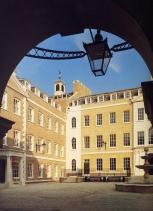

![]()


![]()
|
This large comprehensive development provides offices, flats, shops, two restaurants, community facilities, two underground car parks, and riverside gardens. Two listed buildings along the riverside have been retained and re-fronted, but the rest of the development is new. It exhibits some of the rich variations of English 18th-century architecture, using red and yellow bricks, pantiles, plain tiles, slate and lead, sash and casement windows, and all the five Orders. All the office buildings are designed in accordance with the Georgian requirement of there being 20 feet from the window to the spine wall, so that it can function satisfactorily without air-conditioning or excessive artificial light - although it was a requirement of the fund that these services should be provided and that the floor space should be marketed open plan. Work on the interiors, as with all modern office developments, is carried out after the tenant purchases the property.
In order to provide the variety that is needed on a project of this size on a sloping site, it is desirable to have many different buildings juxtapositioned, rather than one grand scheme; many of the buildings pick up the characteristic details of English and Italian architects, in particular Palladio, Longhena, Sansovino, Hawksmoor, William Chambers and the Gothic revival of the 19th century. |

|

|
|
Whittaker Square: The second-floor window of the west gate was inspired by Bernini's window at Palazzo Chigi-Odescalchi. Exactly the same window was used in 18th-century England, at Beningbrough Hall. The putting to use of Italian details in this way was a notable aspect of the English 18th-century tradition; and once again it seemed appropriate that these motifs should recur in the 20th century.
Italian Villas and Palaces of London: This forms a simplified Corinthian capital with an octagonal column shaft, forming four palm leaves and volutes on the splay with a honeysuckle pattern on the four faces, and a plain square abacus derived from Palazzo Venezia in Rome and the Basilica SS Apoltoli. This is the simplest form of Corinthian capital and, together with the Venetian detail above, produces a composition which provides a relief from the more conventional treatment of the buildings to either side. |

|

|